Going Soft on Kings (Part 1)
Words and Images By Mark Kitteridge

A couple of recent kingfish encounters on softbaits with very different outcomes had me thinking about what a worthwhile challenge they can present.
The first occurred recently after spotting a group of gannets shallow diving into the reasonably shallow water of a sheltered bay. Upon getting within 60-70 metres of the activity I cut the engine, waited for my gliding craft to stop, then cast out a small softbait in baitfish-imitation colours. Not a touch, so I cast out again, and a few seconds later found myself distracted by the occasional watery explosion taking place amongst the feeding gannets. Were they being created by very active gannets chasing mackerel or by crashing kingfish?
Next moment I felt a violent strike that threatened to pull the light outfit from my hands as a good king hit it in full flight head-on. Unfortunately, my startled response involved whipping my rod up firmly and busting off immediately. Fishing softbaits with 10lb braid and a 12lb leader does have its limitations. Indeed, the term ‘knife to a gunfight’ springs to mind...
The second instance was in much deeper water over an area of rugged, uncompromising foul one week earlier. As a positive, I hooked the king midwater while winding in, giving me some valuable fighting space, and I was also fortunate to have one of the gruntiest softbait outfits I’ve ever used at my disposal: a Daiwa Battler ‘Chilli Dog’ rod accompanied by a Daiwa Revelry 4000 reel. Even better, it was loaded with 20lb braid and the 2oz jig-head was knotted to three metres of 25lb fluoro leader with a 7” Bait Junkie on the end.
“ IT’S USUALLY BEST TO DRIVE AFTER THE KINGFISH AND GET ON TOP OF IT TO MINIMISE LINE ANGLE… ”
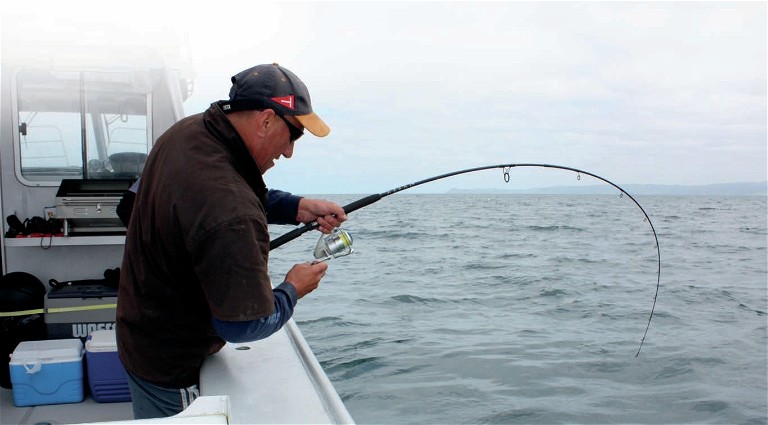

1) It’s often worth working softbaits around channel markers.

2) ‘Fusilier’ coloured softbaits often prove hard to resist, as this kingfish discovered.
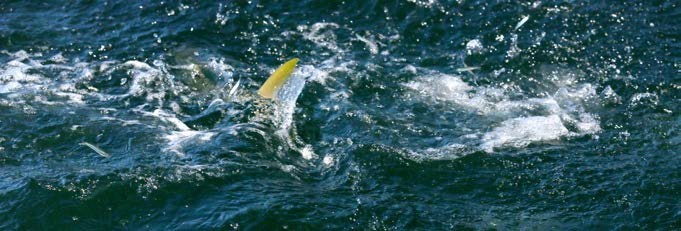
3) Skittering a softbait speedily across the surface is a well-proven technique for kingfish, especially during anchovy season.
The powerful run soon made my opponent’s identity obvious, so I played my part as best I could, endeavouring to stay calm as all the line rushed out. Then, once the run stopped, I kept my lifting and winding actions as smooth as possible. I find kings often respond badly to anglers who try to dominate them with lots of drag pressure and by yanking and jerking the rod around. Sure, this can still lead to a successful outcome, but on the whole this simply sets the alarm bells ringing and puts the kingfish into panic/ destruction mode, making a bustoff on the bottom more likely.
Meantime, my fishing host Scott Malcon was winding in to help at the helm if necessary, aware that the more vertical the ensuing fight remained under the boat, the less likely any structure would get in the way to perhaps end things prematurely.
The choppy conditions weren’t helping our cause, thanks to the wind gusting over 15 knots at times, but perseverance eventually saw a nice king of around 18kg come on board. That’s a pretty decent specimen these days and definitely a cause for celebration, especially when caught on softbait gear.
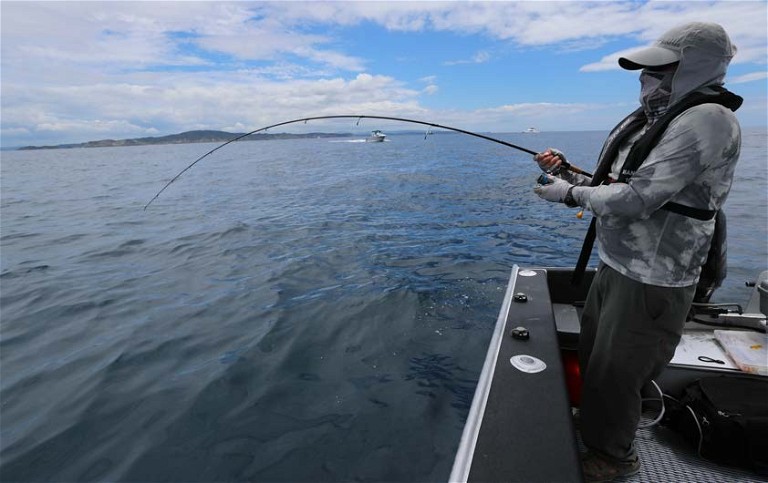
Upon hooking up, don’t panic, and keep everything as smooth as possible when fighting the fish afterwards.
“ SELECT THE BEST REEL YOU CAN AFFORD (AND A BIT MORE!)… ”
Generally speaking, the numbers of kingfish in relation to our abundant snapper means that hooking a legal-sized one on stockstandard snapper-type softbait gear is very much an incidental event. Yet, it probably still happens about once every 10 trips in Auckland waters (more during the warmer months), while the prolific Far North can see anglers locked in battle once or twice a day at least!
Whatever the ratio or geographical location though, every such opportunity is one I relish, because a decent kingfish takes quite a bit of effort, patience and skill to land (as well as a fair degree of luck!). Also, as a decent kingfish usually takes the rod, reel, braid, trace, hook and knot to the limit (and beyond sometimes!), I’m fastidious about ensuring every aspect of tackle is as good as it can possibly be before heading out.
The following suggestions are for other softbaiters who want to be in with a reasonable chance upon hooking one of these formidable sport fish on standard softbaiting gear.
Recommended tackle
The rod: Anything from 7’ through to 8’6” in length, ideally with 15-20lb (PE 1.5-2) braid capabilities. It should also possess a practical-length foregrip so effective leverage and control can be exerted over long periods in comfort. Having to hang onto a bare blank instead is irritating.
The reel: Select the best you can afford (and a bit more!) that holds at least 200 metres of 20lb braid, with 250 or 300 metres being even better. Keep in mind that the larger the reel, the more weighty and cumbersome it will be when fishing for snapper, but that bigger gearing and drag system will work more comfortably within their capabilities when fighting kingfish.
Braid: I mostly use 15-20lb high-vis braid because it’s easier to see, making bites more obvious and enabling a decent amount of pressure to be exerted during tough fights.
Trace: Fluorocarbon is harder to see underwater than nylon and, perhaps even more importantly, is more abrasion-resistant. Kingfish are well known for charging into structure, so every bit of extra protection is valuable. That’s why I start the day off with three metres of trace, generally in 20lb, but often increasing to 25lb when fishing ‘tiger country’. Two of my regular fishing buddies typically tie on 30lb and usually don’t suffer from lack of bites. But occasionally they do. I recommend tying your leader onto the mainline with an FG knot. Yes, it’s a pain to tie, but it’s also strong, streamlined and holds its breaking strain well over time and use.
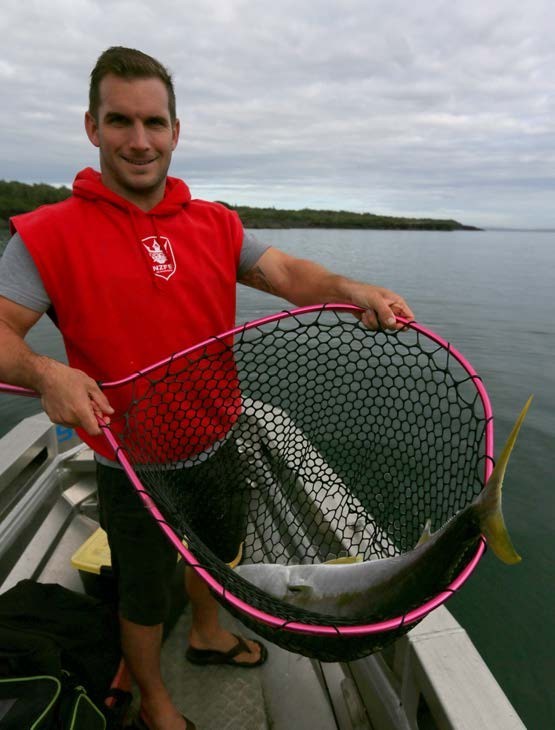
A big net can usually handle kings to at least 13-15kg.
Jig-heads: Obviously the various scenarios encountered will require different weight lead-heads, and your choice of softbait can affect the hook size selected. I suggest choosing a suitably weighted jig-head armed with the smallest hook able to take the maximum pressure likely to be exerted.Unfortunately, hook quality and their respective sizes vary between brands, so if in doubt, choose one of the more reputable brands in a 2/0 or 3/0 size if using 4-5” softbaits, increasing to a 5/0 if using 7” softies. The overall aim is to have the hook point positioned reasonably close to the softbait so it’s hard for one not to be eaten along with the other. However, also keep in mind that denser composition softbaits such as Gulp! do require a little more gape room than much more compressible softbaits such as Bait Junkie and Z-Man.
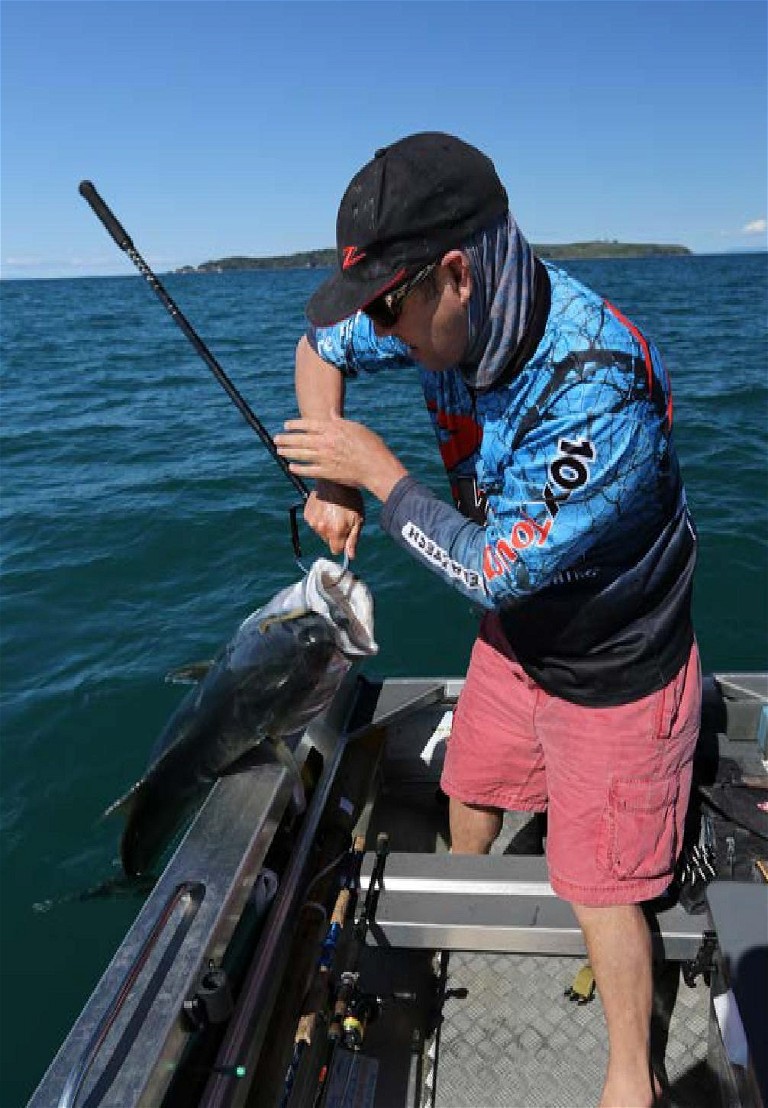
This kingfish was big enough to need a gaff, although lip hooking allowed it to be let go afterwards.
Softbaits: There are no rules about what a kingfish will or won’t eat when it comes to softbaits, but a handful of patterns did emerge while I was going through the potential image selection. Most obvious was the number of kings caught on 7” softies incorporating various pink hues, generally in 30-60 metre depths, followed by various size baits sporting baitfish colours in shallower situations.
There is also one wild card called ‘Fusilier’. Coloured bright green and blue, it’s not especially popular for targeting snapper, but boy, does it attract kingfish!
Tips for more kingfish catches
• Set your drag at the maximum pressure before starting fishing, then leave it alone! Altering the drag mid-fight, with a head full of adrenaline and/or panic, makes it easy for too much pressure to be applied and for something to break.
• If struggling for ascendency over a long fight, experienced anglers can add manual fingertip pressure to the spool when lifting the rod so the maximum length of line is retrieved each lift – yet it’s easy to remove those fingers if the king runs off again.
• It’s often hard to beat sheer lure speed for attracting kingfish bites. Heavier jig-heads are better suited for this role. So when retrieving softbaits from deep down for another cast, especially around work-up situations or near baitfish concentrations, it can pay to wind back up quickly, occasionally adding brief jiggling variations in between. Fast retrieves also work well when casting to anchovy workups with kingfish in attendance in much shallower waters, as well as when testing what might be around the various harbours’ navigation devices.
• Upon hooking a kingfish, try to keep your fighting style as smooth as possible to avoid panicking it into ‘destruction’ mode. Next, if someone’s on board with boat-driving experience, get them on the helm. It’s usually best to drive after the kingfish and get on top of it to minimise line angle, especially in reasonably shallow water, so there’s less chance of being busted off on any structure below. That done, try adding some manual pressure with your fingertips while the helmsman slowly heads the boat out into deeper water. Provided all movements are kept as smooth as possible, it’s surprising how often the king will swim out with you. And should it take off, head after it again, get back on top and repeat the strategy.
• Don’t panic when the kingfish is finally brought near the boat. It will be pretty tired by this stage, so if securing the fish appears challenging, wait for a better opportunity – don’t waste a long fight and impressive catch for the want of another minute or two. A measured gaff shot in the upper shoulder or in the head is recommended if you want to keep it. But if there’s just a net on board or you’d like to release it, wait till the king is swimming towards you, then scoop the net onto it headfirst. If the net is too small to contain the king effectively, grab its tail too, then lift on board together!
Next month we’ll look at targeting kingfish with heavy-duty softbait gear.

Pink softbaits frequently feature in caught kingfish images!